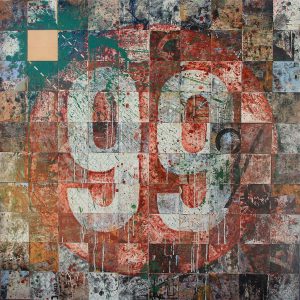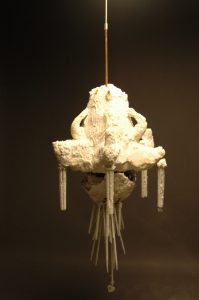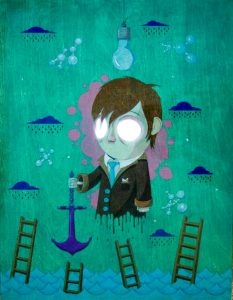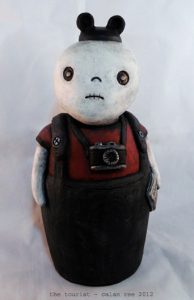An Interview with Featured Artist Bask

By Andi Tomassi and Bask
Andi Tomassi (TROn): Here’s the thing, Bask; Every time I go to a show and see your work, I am immediately drawn in. The part of your aesthetic that I respond to the most is the fact that the developed piece in its finished state is “imperfect” – an aesthetic I know you work toward. I also find that, no matter how busy your pieces get, you demonstrate so much control of composition and balance while maintaining the spontaneous energy of the piece. So, process. Would you say that much of the piece is planned out ahead of time in your mind, or is it something that develops intuitively as you move forward throughout the piece? In that same vein, have any of the finished pieces ever surprised you, or veered away from your original intention?
Bask: Most of my work has a heavily distressed look. Part of that is due to the salvaged material that I paint on, and my goal is for whatever I paint on it for it to look like it belongs there. As though the image suffered the same bumps and bruises as the panel when I found it. The other part is simply because I like distressed images. It makes you focus and look at an image a little longer, as though you were filling in the missing lines. And thus making you connect with it a little deeper.
I almost never sketch out my work before I start a painting. But I do have to have a general vision of the piece and how the layout will be in my head before I can start. Sometimes I stare at a blank piece for days until the layout hits me. But after I start, it usually shifts and I paint on impulse and add or subtract whatever elements are there too much or not enough. I imagine it’s much like being a chef. And as you cook, you add ingredients until you get something you feel is worth tasting. In my case, worth looking at.
AT: A major theme throughout your work is Thoughtcrime, which you define on your website as “an idea or belief that defies the norms of the status quo.” Obviously this is an Orwellian reference, which I love, and it begs two questions: How old were you when you first read 1984, and what would you say is your most truly nonconformist belief?
Bask: I have connected quite a bit with George Orwell’s 1984. But on a level which is overwhelmed with coincidence and overlap. I immigrated to the United States in 1984 from the oppressive communist system that ruled over my home land of, then Czechoslovakia, now Czech Rep. My parents escaped with me and my sister at their side. The day we escaped my dad’s sister, my aunt, was murdered and we lived in an Austrian refugee camp for six months before getting a sponsor to emigrate. It was a very traumatic and difficult time. But thanks to the strength of my parents, we made it, and my sister and I got a chance at freedom. I didn’t read the book until my late teens. I was familiar with Animal Farm, which I love, too, but 1984 changed my life. Both the book and the actual year.
As for Thoughtcrimes and nonconformist beliefs, it’s not a single one that I can identify. It’s more of a general way to walk through life. Question authority, follow your bliss, and pursue the dreams and happiness you feel entitled to. Once you open up to that, then all of your thoughts become Thoughtcrimes. Once you stop living for other people’s expectations, be that consumer-based or peer-pressure, and start living and thinking your own way, there’s a path where you get to discover who you are and what your purpose is.
AT: Which authors/philosophies would you say are under your skin these days?
Bask: Orwell of course, Joseph Campbell, Allan Watts, Noam Chomsky, Howard Zinn, Charles Bukowski, and even The Art Of War by Sun Tzu.
AT: You’ve said that your family immigrated to the States in 1984. Do you remember much of that experience? I know many artists/authors attempt to address their parents’ experience, but I was wondering if you could speak a little more to the impact it made on you as a person and maybe relay to our readers any ideas that you had at a young age of “America” that might have been influenced by either propaganda or mass media.
Bask: I remember the experience vividly. I’m certain that the experience is deeply imbedded in me and affects all aspects of my life. It’s why I’m skeptical of every “new great thing” that comes to the consumer market. It all reminds me of the same brainwashing propaganda I got growing up in Europe. And it’s not just the persistent influence. My family experienced first-hand what can happen if you don’t submit and go with the flow. Similar pressures are pushed by media and brands every day. It’s why the term, “Keeping up with the Joneses” exists. Pressure by society fueled by marketing to live a certain way, even if it has no actual benefit to our everyday life.
AT: I’ve heard some say that ad men are the gods of our time. How do you feel about that, and where do you fit into this equation, as a creative artist using/reusing popular iconography?
Bask: I have a love-hate relationship with ad men. I hate how their work controls and influences society, but I love how smart and effective some of it is. Just like the effectiveness of propaganda art, but better. It’s work that tugs at your heart and can actually feel inspiring if done right. Since advertising is everywhere and most of it is just garbage and eye pollution, I really appreciate when I see or hear it done right. But again, I hate how effective it can be and almost resent when I feel moved by something that is just trying to sell me a pair of shoes, for example.
AT: So, most people who are interested in street art have probably come across Banksy’s decision to use stencils while hiding from the police under a car (or so the story goes.) What do you think are the current stereotypes that surround graffiti/street artists? On a personal note, is most of your work commissioned, or do you have any stories of your own that you’d like to share with us?
Bask: My favorite stereotype about graffiti and street art is that companies think they can buy street-cred when adopting it into their advertising. And at face value, they are, and the artists they use get paid very well most of the time, but real graffiti and real street art is gnarly and rugged around the edges and is completely unusable to sell anything apart from the image or tag or bomb the artist uses it for or what it is defacing. Like doing a huge tag with a fire extinguisher full of paint. Whenever street art or graffiti start to get too commercial, it has a wonderful self-balancing agent naturally imbedded into it that will always bring it back to the gully side where it came from. It’s called youth and rebellion.
As for me, I spend most of my days in studios or permission murals that let me experiment with images and techniques beyond the adrenalin thrill of doing illegal street art. I like to play with my medium and see how far I can take certain images. I still get up once in a while but it’s more for the nostalgia of what I used to do more often. It’s something that will always be in part of me. If I have a marker in my pocket there is a 100% probability that I will draw or tag on something I’m not supposed to.
AT: So many artists have had problems with appropriation. Shep Fairey’s efforts with the Obama campaign poster/ subsequent trouble with AP is old news now, Roy Lichtenstein’s appropriation of Picasso . . . who was appropriating from—everyone?—even older news. Still, appropriation itself is as current as ever. What in your opinion makes an image free game (or are there any that are off-limits)? Do you ever worry about the use of popular iconography in your own work?
Bask: To me it’s all free game. Pop culture is all around us, and it’s part of our lives. I constantly incorporate brands and images that are not my own into my art. But it’s up to the artist to do more with them than just plagiarize. I feel like a DJ mixing a set when in the studio. I bring in samples but layer them between my own images and out comes something unique and original. Yes, there may be an image of Mickey Mouse, but I guarantee it’s like nothing you’ve seen before and in a manner that Disney would never portray him.
But this question is as old as pop art. Warhol was constantly getting sued by brands that didn’t want him using their trademarked images. But legally, if you alter an image at least 20% then legally it no longer is the official trademarked brand. That may be different for the use of licensed photographs, but I know I can use the Pepsi logo all day long if I tweak it enough.
AT: Roy Lichtenstein felt he finally had to paint a Picasso to rid himself of Picasso’s influence. Are there any artists/themes that you feel you have not been able to exorcise or that you see returning to your work again and again?
Bask: Not really. I have so many creative influences but value the impact they have on my art. I am self-taught, so I was never over-exposed to anything I didn’t want to be. So all of my influences have a welcome place in my brain.
AT: And in a 2008 article with Redefine magazine you said, “Street art is becoming so mainstream that the figurative pond is becoming muddied up. But like everything else, time will sift out the true from the rest.”
Have your feelings changed at all in the past four years? And what, in your opinion, is the definitive mark of the “true” street artist? Who would you enlist among them?
Bask: I still stand by that. And I feel like since that article was written, I have only been proven right. In the past few years, there has been a huge influx of incredible artists doing things in the street. Mind-blowing things. Artists like Barry Mcgee, Revok, Os Gemeos, Roa, How and Nosm, Rime, Retna, and countless others are doing incredible work. Both in and off the streets.
AT: In terms of visual art, do you ever feel that there are certain works that have been exhausted or so attached to their original brand/another street artist, that you’ve decided not to use them? (As I’m writing this, I’m thinking of Che Gueverra, the Mona Lisa . . . Not to say they are used-up, but the question remains.)
Bask: Yes, of course, and the examples you’ve given are perfect. Some iconic images have just been beaten to death and there is nothing original in their appropriation anymore. Just like with any art, you have to constantly search for the path not taken. I am immediately turned off from using an image or slogan in my work if I even catch a glimpse of someone else using it. I just don’t go there if I see someone else has already set up camp, so to speak.
AT: Conversely, the fact that these images are used and reused shows us the power of the hook. (And the power of the Pop Art movement.) What would you say is your most powerful visual hook. Which one do you find your audience the most attached to, and why do you think this is the case?
Bask: In the Thoughtcrime series, I use and reuse a series of images that play into what that word means to me. The guy smiling while holding the explosive and oversized grenade. Or the ant carrying a large light bulb on its back. These images are metaphors for what a Thoughtcrime symbolizes to me. I reuse these images time and again for exactly their repetitive nature. But that is hopefully offset with the diversity of my overall portfolio.
AT: What do you have in the works now?
Bask: I’m getting ready for the release of a certain Marvel film which I did a lot of work for last year. I can’t really say much more about it until May when it comes out. But otherwise a tour of group shows from New Jersey to Denver. I will also be part of the Sunset Film Festival in St. Petersburg this April.
Also, I just finished “Love Hope Strength” for the Black Book Gallery in Denver Co. and a Cancer benefit they are hosting this April. All of the proceeds from the sale my work will go to the “Love Hope Strength Foundation” in memory of my friend Thomas Horne’s twin brother who died of leukemia last year.
AT: What if our viewers want more of Bask? Where can they find your work?
Bask: The usual places of social media. Flickr, Facebook, Twitter, Tumblr, and my website, knownasBask.com.
Love Hope Strength
Das Monster
99
Road To Hell
There’s a Thin Line Between a Social Drinker and a Drunk
Thought Crime Installation
Kind of a Big Deal
Apocalypse Now
ThoughtCrime Installation
We the People, Yes We Can
============================================================================
 Bask is the moniker of one Ales Bask Hostomsky, who along with his parents emigrated from Czechoslovakia to Florida and began to soak up America’s popular iconic imagery along with the sun. He quickly began to notice similarities between the communistic iconic propaganda from his youth and the consumer advertising of his teens. Bask soon discovered that they were simply two sides of the same coin, each vying for our short-lived attention spans, all the while selling us (or telling us?) anything and everything from Marxism to McDonalds. Seeking conspiracies – and finding them embedded in the popular iconography of the mass media – Bask began painting bold, media-critical broadsides to assuage his fear of being manipulated. A fear cultivated in a repressive regime had now returned, but to the most unlikely and safest of places – The American living room.
Bask is the moniker of one Ales Bask Hostomsky, who along with his parents emigrated from Czechoslovakia to Florida and began to soak up America’s popular iconic imagery along with the sun. He quickly began to notice similarities between the communistic iconic propaganda from his youth and the consumer advertising of his teens. Bask soon discovered that they were simply two sides of the same coin, each vying for our short-lived attention spans, all the while selling us (or telling us?) anything and everything from Marxism to McDonalds. Seeking conspiracies – and finding them embedded in the popular iconography of the mass media – Bask began painting bold, media-critical broadsides to assuage his fear of being manipulated. A fear cultivated in a repressive regime had now returned, but to the most unlikely and safest of places – The American living room.
Andi Tomassi graduated from the University of South Florida with a dual-major BA in Visual & Performing Arts and Art Education. She is currently an MFA candidate at the University of Tampa.


































